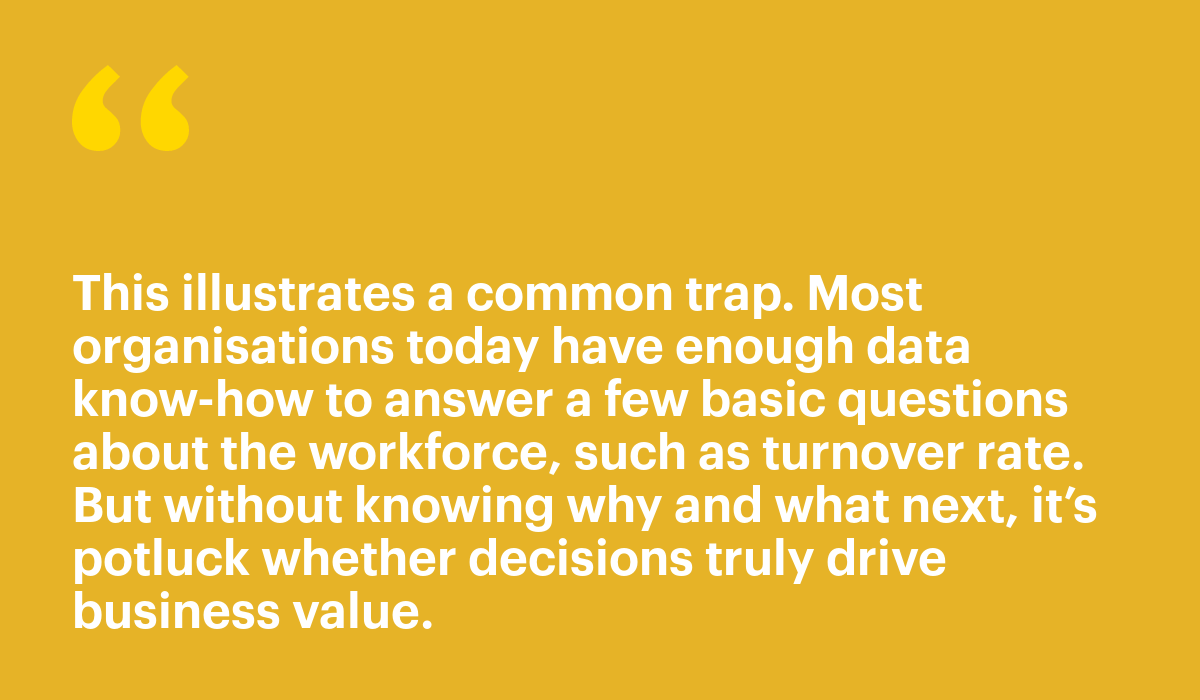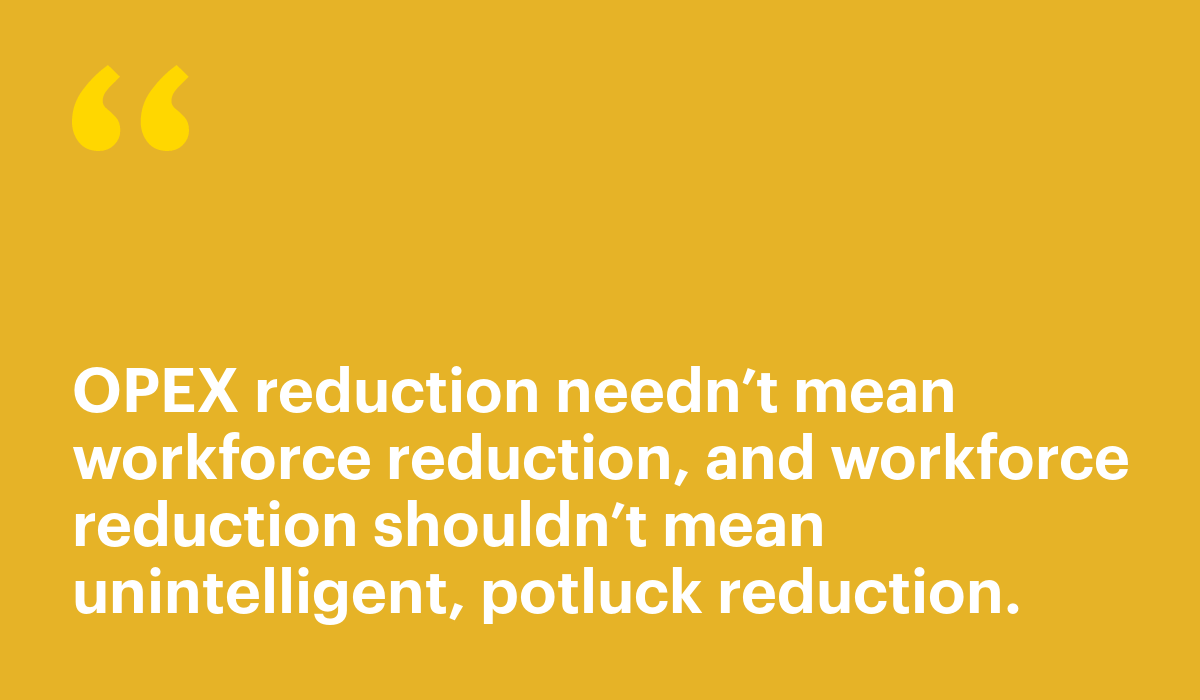5 Tactics to Reduce Operating Expenses Through People Analytics
Too high OPEX may seem to demand downsizing. But you can reduce operating expenses with smart workforce analytics.

The disruption of the past few years has left many organisations keeping a closer rein than ever on operating expenses. Organisations looking to reduce OPEX turn their attention first to the workforce. Your workforce is one of your largest operating expenses—but it’s also your biggest asset. This tension means the stakes are extremely high to make the right workforce decisions.
Workforce reduction might be the obvious answer to cut people costs—and is sometimes unavoidable—but downsizing risks long-term damage to morale, engagement, and productivity that’s hard to overcome.
Reduce OPEX without layoffs
In this article, we’ll explore some strategies to reduce OPEX through managing your people spend, including several options that don’t involve a reduction in force. You’ll see how, armed with continuous, detailed, actionable people data, you can streamline people-related operating expenses without sacrificing productivity or long-term growth.
The secret? Workforce analytics. An International Data Corporation (IDC) report found Visier delivered an average 5-year ROI of 293% with an average 7.5 month payback period, including reducing operating expenses by $79,000 and creating $286,000 additional new revenue.
Let’s dive in.
1. Optimise talent acquisition efficiency
According to recent benchmarking data by SHRM, the average cost-per-hire is around £3800, but may run to three or four times the position’s salary. Internal costs—like talent acquisition salary costs—are a major contributor to cost-per-hire. Ensuring you’re using your hiring resources efficiently is crucial.
Are your recruiters attracting an efficient pool of quality candidates, or are they wasting time screening mountains of unsuitable applications?
Are your hiring managers presented with a tight ratio of great people, or are they wasting time reviewing and interviewing unqualified candidates?
Are you paying people the right amount, or could you decrease salary offers without impacting offer acceptance rates?
People analytics optimises the talent acquisition function giving detailed insights into key recruitment pipeline questions and highlighting improvement opportunities.
2. Decrease voluntary turnover
High voluntary turnover drives up recruitment costs, as talent acquisition scrambles for replacements. Turnover has huge direct and indirect costs so it’s clearly a problem that needs solving. But sometimes organisations launch an expensive (and usually ineffective) cycle of raising base salaries as an attempt to combat attrition.

This illustrates a common trap. Most organisations today have enough data know-how to answer a few basic questions about the workforce, such as turnover rate. But without knowing why and what next, it’s potluck whether decisions truly drive business value.
Sophisticated workforce analytics help you develop a data-driven turnover reduction strategy that makes sense for the organisation. This strategy should ultimately reduce the pressure on recruitment to hire replacements and therefore cut OPEX.
3. Grow skills internally
Skills gaps are a major driver for headcount requirements, as talent acquisition are tasked to bring people into the business to support future growth. Building the right skills mix is critical to innovation.
Organisations can address this skills challenge three ways: through reallocating, recruiting, or reskilling. Better workforce analytics can help with all three, but it’s especially pertinent from a OPEX reduction perspective to look at reskilling.
The better your mechanism for identifying and filling skills gaps, the less you need to recruit externally.
4. Evaluate your hybrid work policy
Recent research found remote working can slash operational costs by one third, depending on your sector. Real estate cost savings shouldn’t necessarily be the dominant motivator for flexible working, but cost savings can be a positive consequence of smart, data-led workforce decisions.
People analytics will guide you towards those decisions, providing a clear line of sight into the workforce’s needs and challenges. This is the path to building a work model that makes sense, both for your people and financially.
5. Map your true total cost of workforce
One of the biggest barriers to effective workforce cost optimisation is the inability of most organisations to effectively map their total cost of workforce (TCOW). As this data is usually spread across multiple systems, most organisations don’t have anywhere near the data accuracy or granularity to calculate how much their workforce costs. They also lack the sophisticated ability to use workforce segmentation to understand where spend could be meaningfully reallocated without hurting productivity.
People analytics provides quick and simple answers to questions like these, showing you an instant breakdown of your workforce costs, both at a birds’ eye and granular level. Watch this webinar to see this process in action.
The ultimate output of these insights might be a need for workforce reduction. But if so, you’ll learn how and where to make reductions to minimise adverse impact on productivity, rather than relying on gut feel and knee-jerk decisions.
Cut costs and create value with people analytics
The workforce is both your biggest asset and one of your biggest costs. This tension makes it an obvious candidate for OPEX reduction, but keeping the right people in the right places, engaged and productive, is integral to today’s and tomorrow’s performance.

OPEX reduction needn’t mean workforce reduction, and workforce reduction shouldn’t mean unintelligent, potluck reduction.
People analytics ingests data that’s refracted across myriad HR systems, to reveal opportunities for optimisation. Often, these opportunities offer significant cost-efficiencies that reduce OPEX without any need for layoffs. Streamline workforce costs without sacrificing long-term growth.
Want to learn more about how people analytics can help reduce operating expenses? Schedule a demo today.


